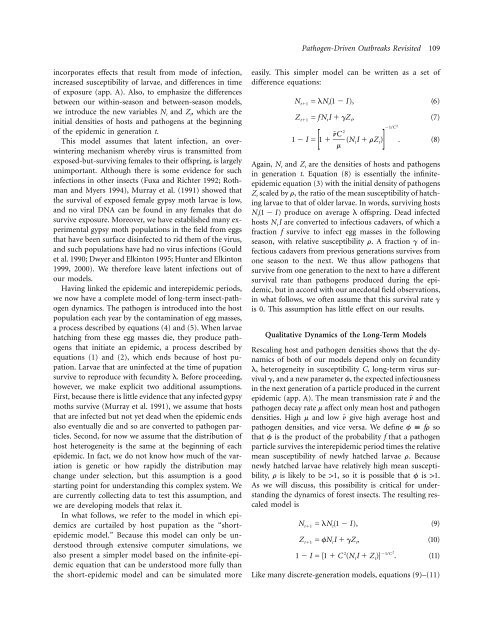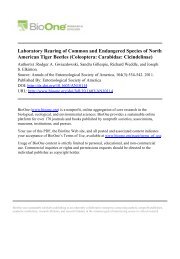Building Models from Experimental Data. - elkintonlab
Building Models from Experimental Data. - elkintonlab
Building Models from Experimental Data. - elkintonlab
You also want an ePaper? Increase the reach of your titles
YUMPU automatically turns print PDFs into web optimized ePapers that Google loves.
Pathogen-Driven Outbreaks Revisited 109<br />
incorporates effects that result <strong>from</strong> mode of infection,<br />
increased susceptibility of larvae, and differences in time<br />
of exposure (app. A). Also, to emphasize the differences<br />
between our within-season and between-season models,<br />
we introduce the new variables N t and Z t , which are the<br />
initial densities of hosts and pathogens at the beginning<br />
of the epidemic in generation t.<br />
This model assumes that latent infection, an overwintering<br />
mechanism whereby virus is transmitted <strong>from</strong><br />
exposed-but-surviving females to their offspring, is largely<br />
unimportant. Although there is some evidence for such<br />
infections in other insects (Fuxa and Richter 1992; Rothman<br />
and Myers 1994), Murray et al. (1991) showed that<br />
the survival of exposed female gypsy moth larvae is low,<br />
and no viral DNA can be found in any females that do<br />
survive exposure. Moreover, we have established many experimental<br />
gypsy moth populations in the field <strong>from</strong> eggs<br />
that have been surface disinfected to rid them of the virus,<br />
and such populations have had no virus infections (Gould<br />
et al. 1990; Dwyer and Elkinton 1995; Hunter and Elkinton<br />
1999, 2000). We therefore leave latent infections out of<br />
our models.<br />
Having linked the epidemic and interepidemic periods,<br />
we now have a complete model of long-term insect-pathogen<br />
dynamics. The pathogen is introduced into the host<br />
population each year by the contamination of egg masses,<br />
a process described by equations (4) and (5). When larvae<br />
hatching <strong>from</strong> these egg masses die, they produce pathogens<br />
that initiate an epidemic, a process described by<br />
equations (1) and (2), which ends because of host pupation.<br />
Larvae that are uninfected at the time of pupation<br />
survive to reproduce with fecundity l. Before proceeding,<br />
however, we make explicit two additional assumptions.<br />
First, because there is little evidence that any infected gypsy<br />
moths survive (Murray et al. 1991), we assume that hosts<br />
that are infected but not yet dead when the epidemic ends<br />
also eventually die and so are converted to pathogen particles.<br />
Second, for now we assume that the distribution of<br />
host heterogeneity is the same at the beginning of each<br />
epidemic. In fact, we do not know how much of the variation<br />
is genetic or how rapidly the distribution may<br />
change under selection, but this assumption is a good<br />
starting point for understanding this complex system. We<br />
are currently collecting data to test this assumption, and<br />
we are developing models that relax it.<br />
In what follows, we refer to the model in which epidemics<br />
are curtailed by host pupation as the “shortepidemic<br />
model.” Because this model can only be understood<br />
through extensive computer simulations, we<br />
also present a simpler model based on the infinite-epidemic<br />
equation that can be understood more fully than<br />
the short-epidemic model and can be simulated more<br />
easily. This simpler model can be written as a set of<br />
difference equations:<br />
N t1 = lN t(1 I), (6)<br />
Z = fN I gZ , (7)<br />
t1 t t<br />
[ ]<br />
1/C 2<br />
¯nC 2<br />
1 I= 1 (NtI rZ t) . (8)<br />
m<br />
Again, N t and Z t are the densities of hosts and pathogens<br />
in generation t. Equation (8) is essentially the infiniteepidemic<br />
equation (3) with the initial density of pathogens<br />
Z t scaled by r, the ratio of the mean susceptibility of hatching<br />
larvae to that of older larvae. In words, surviving hosts<br />
N t(1 I) produce on average l offspring. Dead infected<br />
hosts N t I are converted to infectious cadavers, of which a<br />
fraction f survive to infect egg masses in the following<br />
season, with relative susceptibility r. A fraction g of infectious<br />
cadavers <strong>from</strong> previous generations survives <strong>from</strong><br />
one season to the next. We thus allow pathogens that<br />
survive <strong>from</strong> one generation to the next to have a different<br />
survival rate than pathogens produced during the epidemic,<br />
but in accord with our anecdotal field observations,<br />
in what follows, we often assume that this survival rate g<br />
is 0. This assumption has little effect on our results.<br />
Qualitative Dynamics of the Long-Term <strong>Models</strong><br />
Rescaling host and pathogen densities shows that the dynamics<br />
of both of our models depend only on fecundity<br />
l, heterogeneity in susceptibility C, long-term virus survival<br />
g, and a new parameter f, the expected infectiousness<br />
in the next generation of a particle produced in the current<br />
epidemic (app. A). The mean transmission rate ¯n and the<br />
pathogen decay rate m affect only mean host and pathogen<br />
densities. High m and low ¯n give high average host and<br />
pathogen densities, and vice versa. We define f { fr so<br />
that f is the product of the probability f that a pathogen<br />
particle survives the interepidemic period times the relative<br />
mean susceptibility of newly hatched larvae r. Because<br />
newly hatched larvae have relatively high mean susceptibility,<br />
r is likely to be 11, so it is possible that f is 11.<br />
As we will discuss, this possibility is critical for understanding<br />
the dynamics of forest insects. The resulting rescaled<br />
model is<br />
N t1 = lN t(1 I), (9)<br />
Z = fN I gZ , (10)<br />
t1 t t<br />
2 1/C<br />
1 I=[1 C (N I Z )] 2<br />
t t . (11)<br />
Like many discrete-generation models, equations (9)–(11)



